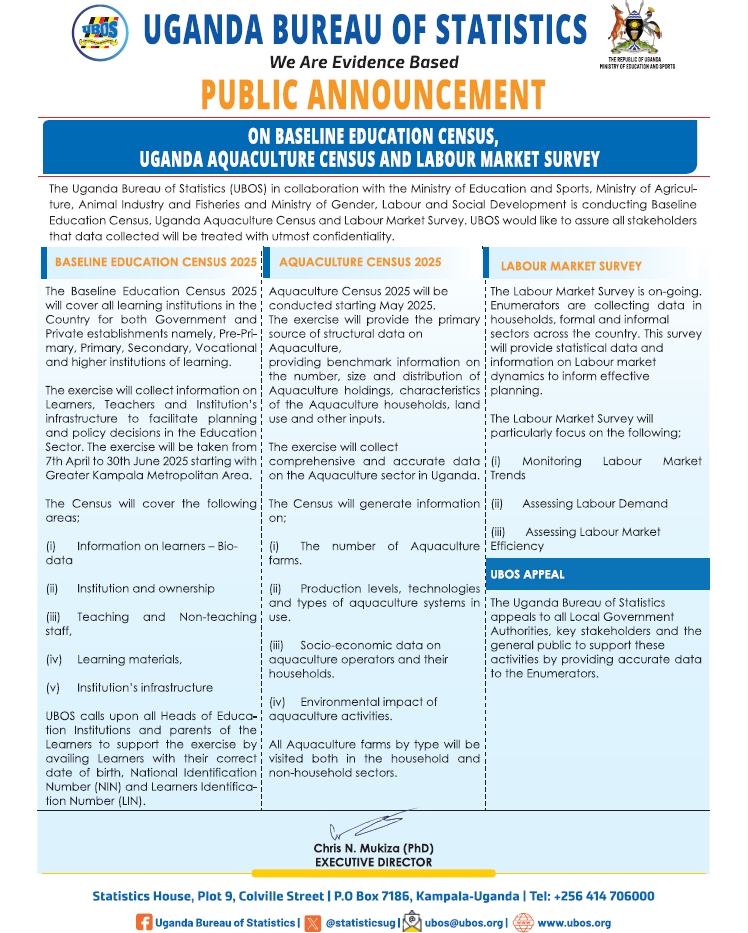UGANDAS income inequality has decreased, with the national Gini coefficient dropping from 0.413 in 2019/20 to 0.382 in 2023/24,), Uganda National Household Survey (UNHS) 2023/24 conducted by Uganda Bureau of Statistics (UBOS has revealed.
The report indicates that rural areas saw their Gini index fall to 0.351, while urban areas improved to 0.384 like Buganda South, Elgon, Karamoja, and Lango recorded the most notable declines in inequality.
Conducted between 2023 and early 2024, the UNHS is Uganda’s eighth comprehensive household survey since 1999/2000, covering 17,000 households across 14 sub-regions and refugee settlements. The findings will guide national development planning and policy interventions.

According to the report Buganda South’s Gini index, for instance, fell sharply from 0.428 to 0.304, suggesting better economic opportunities or more balanced wealth distribution.
However, poverty remains a pressing issue, with 16.1% of Ugandans (approximately 7 million people) living below the absolute poverty line—defined as surviving on less than $1 per day
Karamoja remains the hardest-hit region, with 74.2% of its population in poverty—the highest in the country. The region also has the widest poverty gap (31.5%), indicating a need for massive financial intervention. Busoga, Bukedi, and Teso follow closely, with poverty rates exceeding 30%.
In contrast, Kampala has the lowest poverty incidence (1.1%), requiring minimal intervention to eliminate extreme poverty. Ankole (3.2%) and Buganda South (6.0%) also reported relatively low poverty rates.
The survey reveals a structural shift in Uganda’s labor market, with the services sector now employing 47.3% of workers, up from 39.8% in 2019/20. This growth reflects expanding opportunities in education, health, retail, and financial services.
Meanwhile, agriculture’s share of employment has dropped to 40.1%, down from 50.3% in 2019/20, signaling a gradual move away from subsistence farming. The industrial sector (manufacturing and construction) remains stagnant at 12.6%, underscoring slow industrial growth.
About 82% of Ugandans sought medical care when ill, with private facilities handling over half of all cases. However, 12% did not seek treatment, citing reasons such as mild illness, self-medication, lack of funds, or distance to health centers.
Encouragingly, 90% of Ugandans now live within five kilometers of a health facility, up from 86% in 2016/17.
While primary school gross enrollment rose slightly to 119.5%, net enrollment fell to 77.9%, indicating over-aged or under-aged children in classrooms and possible dropout issues.
Secondary school enrollment is more concerning, with gross enrollment dropping to 33.6% and net enrollment at just 23.2%, with girls slightly lagging behind boys.
Ugandan households spend 44.2% of their income on food and non-alcoholic beverages, with rural areas exceeding 50%. Urban households allocate more to housing, transport, and education, reflecting differing economic pressures.
Child poverty is significantly higher in rural areas (21.4%) than in urban centers (12.9%). Karamoja’s child poverty rate is alarming at 77.7%, demanding urgent policy action.


